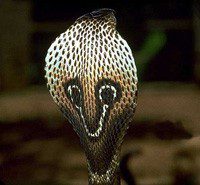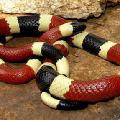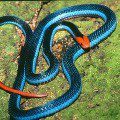
Two-banded glandular snake
The ferruginous two-striped snake belongs to the most numerous snake family in the order of snakes and has all the relevant features. She has a thin and slender body and is generally very beautiful. The colors of this snake are orange, black and blue. And it is also incredibly poisonous, which is emphasized in the very name of the reptile – glandular. This snake has overdeveloped venom glands, and they are located not only in the head region, like in other aspids, but also continue into the body cavity, occupying almost a third of its length. Because of this, the heart and other organs of the snake are, as it were, pushed back. Its poison is very dangerous for humans and animals, first of all it acts on the central nervous system of the victim.
Contents
Classification
Kingdom: Animalia (animals)
Type: Chordata
Class: Reptilia (reptiles)
Order: Squamata (scaly)
Suborder: Serpentes (snakes)
Family: Elipidae (aspididae)
Genus: Iron snakes (Maticora)
Species: Maticora bivigrata (two-banded glandular snake)
Appearance
 The glandular two-striped snake reaches a length of approximately 1 meters. It is distinguished by a highly unusual coloration – a black-blue back and light blue sides with white stripes on each side, and a head, belly and tail of a reddish or orange hue. Such brightness serves as a warning signal of danger, saying: “Caution, poison! “. The muzzle of the snake is slightly blunt, the eyes are small and located on the sides of the head. The scales are smooth and shiny. As already mentioned, the unique quality of the glandular two-banded snake is the excessive development of venom glands. Because of this structure, the internal organs, in particular, the heart of the reptile, are pushed back into the body cavity, almost to its very middle. What is the reason for this property, scientists have not yet found an answer. Moreover, a similar feature is also found in some coral snakes, among which there are species with poisonous glands continuing incredibly deep into the body cavity, almost to the tail. Like all asps, the glandular snake lacks a left lung. Paired poisonous teeth are noticeably larger than other teeth, with a poisonous canal, pushed forward on the jaw, slightly bent back and absolutely motionless. The snake periodically changes poisonous teeth, of which only one functions normally, and the second is, as it were, a replacement for it in case of loss. She also has small teeth on the upper, pteroid, palatine, and dentary bones.
The glandular two-striped snake reaches a length of approximately 1 meters. It is distinguished by a highly unusual coloration – a black-blue back and light blue sides with white stripes on each side, and a head, belly and tail of a reddish or orange hue. Such brightness serves as a warning signal of danger, saying: “Caution, poison! “. The muzzle of the snake is slightly blunt, the eyes are small and located on the sides of the head. The scales are smooth and shiny. As already mentioned, the unique quality of the glandular two-banded snake is the excessive development of venom glands. Because of this structure, the internal organs, in particular, the heart of the reptile, are pushed back into the body cavity, almost to its very middle. What is the reason for this property, scientists have not yet found an answer. Moreover, a similar feature is also found in some coral snakes, among which there are species with poisonous glands continuing incredibly deep into the body cavity, almost to the tail. Like all asps, the glandular snake lacks a left lung. Paired poisonous teeth are noticeably larger than other teeth, with a poisonous canal, pushed forward on the jaw, slightly bent back and absolutely motionless. The snake periodically changes poisonous teeth, of which only one functions normally, and the second is, as it were, a replacement for it in case of loss. She also has small teeth on the upper, pteroid, palatine, and dentary bones.
Due to its natural brightness, it is quite easy to notice the glandular two-banded snake in nature, however, it rarely catches the eye, as it is a very cautious and secretive creature. This snake goes hunting mainly at night, preferring to be in shelters during the day. But even if you accidentally stumble upon her at dusk, she would rather run away than attack and bite. Due to its unusual coloration, the glandular two-banded snake is sometimes called the blue asp. By the way, between terrestrial cobras and decorated asps, the group of which also includes two-striped snakes, there is a transitional link – night bungar snakes, like glandular ones, who tend to hide in various shelters during daylight hours.
Distribution and habitation
The ferruginous two-banded snake is characteristic of the territories of Southeast Asia, in particular, countries such as Thailand, Laos, Cambodia, as well as the Malay Peninsula and the Sunda Islands. It settles mainly in forests and agricultural lands. The climate in the snake’s habitat is characterized by moderate humidity. You will not meet her in bare spaces, since the snake needs to hide in vegetation, and it can be both trees and shrubs. The glandular two-striped snake hides in different places – in other people’s holes, under the roots of plants, in heaps of windbreak and stones. She prefers to settle down and uplands from 500 to 900 meters, and lowlands. Often found near water bodies. Sometimes this snake is called a semi-burrowing species because of its love to burrow into various substrates – fallen leaves, soft ground under trees, small stone mounds, etc.
Behavior and lifestyle
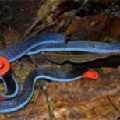 The glandular two-striped snake is extremely cautious. To see it and observe it, you have to try. The most frequent pastime of a reptile is lying motionless right on the ground. At the same time, the snake bends, but does not fold the body, like some of its relatives during rest.
The glandular two-striped snake is extremely cautious. To see it and observe it, you have to try. The most frequent pastime of a reptile is lying motionless right on the ground. At the same time, the snake bends, but does not fold the body, like some of its relatives during rest.
Despite the dangerous poison, the glandular two-banded asp bites very rarely. If he collides with the enemy, then instead of attacking and attacking, he will try to deceive him. At the same time, the snake begins to take absolutely incredible poses – it turns its body, bends its head and raises its bright tail high, thus trying to disorient the enemy, passing off a less traumatic part of its body as a head. The attacks of the glandular two-striped snake in such a situation are also deceptive and, running away, it begins to move a little awkwardly, as if twitching. It is interesting that this behavior, which is characteristic not only of the glandular asp, but also of some other representatives of the detachment, for example, snakes, rubber snakes or the Calabria python, at one time gave rise to many legends. Because of it, in ancient times such snakes were called “amphisbaena” – translated from Greek as two-headed. Legends about two-headed snakes with their drawings and even decorations in the form of “amphisbaen” are among the most diverse peoples, for example, among the ancient peoples who lived on the American mainland.
The sight and hearing of the glandular snake is rather weak, so that with its small pupil it sees much better in the dark. And it’s also easy to get close to her, since the snake simply won’t hear the approach. However, at night, the glandular asp becomes more vigilant and if it does bite a person, he may soon die from suffocation. And inattention is likely to lead to a bite, for example, cases when a person accidentally steps on a reptile. The two-striped glandular snake moves in the same way as it lives – quite measuredly and lazily.
Food
Cannibalism is characteristic of ferruginous two-striped snakes, however, not in relation to their own kind. They hunt for dwarf snakes – calamaria – and rarely allow themselves other prey. But sometimes a lizard, a frog or a bird can become a victim of a snake. Almost nothing is known about how to feed this snake in captivity, since keeping it in a terrarium is fraught with certain difficulties.
Reproduction
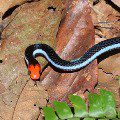 Since zoologists have not yet been able to carefully study the life of the glandular two-striped snake under artificial conditions, very little is known about its reproduction, and some information is conjectural. In particular, it is an oviparous reptile. In its clutch there are from 1 to 3 leathery eggs typical for snakes. Behavior during the mating season is shrouded in mystery. And nesting, perhaps, is carried out in the same shelters where the snake lives. That is, the nest can be arranged very simply, but not in any place, but in a pile of suitable organic material, where suitable temperature, humidity and protection from predators are easily provided. Accordingly, like all other egg-laying snakes, the glandular two-banded asp does not show any concern for the offspring after its birth. Nevertheless, he probably guards the masonry.
Since zoologists have not yet been able to carefully study the life of the glandular two-striped snake under artificial conditions, very little is known about its reproduction, and some information is conjectural. In particular, it is an oviparous reptile. In its clutch there are from 1 to 3 leathery eggs typical for snakes. Behavior during the mating season is shrouded in mystery. And nesting, perhaps, is carried out in the same shelters where the snake lives. That is, the nest can be arranged very simply, but not in any place, but in a pile of suitable organic material, where suitable temperature, humidity and protection from predators are easily provided. Accordingly, like all other egg-laying snakes, the glandular two-banded asp does not show any concern for the offspring after its birth. Nevertheless, he probably guards the masonry.
Sources of
http://www.zmeuga.ru
http://www.ecologyasia.com
http://forum.zoologist.ru
http://en.wikipedia.org




